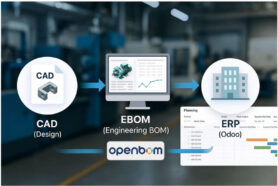
In the modern digital business landscape, data takes the leadership role to support business. While the original goal of all product lifecycle management, product data management, supply chain management, and other aspects of “data management” was about how to hoard the data created during the product development process and document using different PLM and document management tools, modern PLM platforms and tools is taking a different approach.
Data holds the power to fuel innovation, drive new processes, and mitigate various risks within the realms of supply chain management and regulatory compliance. Yet, accessing and harnessing the full potential of data can be a daunting task, especially when it comes to managing intricate product information buried deep within spreadsheets, legacy databases, and a myriad of enterprise applications like PLM, ERP, and CRM systems.
OpenBOM – PLM Upside Down
The original PLM software was created to hoard product data during the product lifecycle, to control business processes, and to control who has access to the data (eg. CAD files, change records, etc). At OpenBOM, we took the opposite approach. The ROI of OpenBOM is focusing on how to connect processes and streamline information transfer. While this is the first goal of OPenBOM, the second one is even more important – to collect the information businesses are creating while designing and building products and turn it into intelligence.
At OpenBOM, we are on a mission to empower businesses by granting them access to product information gathered from diverse sources and then using our advanced Graph-Based data management platform to extract valuable intelligence from this data. With OpenBOM’s flexible data model, we can seamlessly integrate multiple slices of product and enterprise data and harmonize them using cutting-edge integration methods and semantic modeling capabilities. This integration includes data from Excel, multi-CAD systems, and various other enterprise applications. Our platform offers an out-of-the-box data model as well as the flexibility to import data from a wide array of sources.
Let’s dive into the five invaluable insights that become accessible when you bring your data into OpenBOM:
Product and BOM Traceability
OpenBOM performs a magical feat by automatically providing product and Bill of Materials (BOM) traceability. The “Where Used” feature becomes a powerful tool once OpenBOM fuses data from multiple projects, assemblies, and catalogs. Graph navigation and analytics help you to trace all about specific items or assemblies. This capability allows you to visualize (using Graph Navigation) how each component fits into the larger product structure, providing a comprehensive understanding of your product’s architecture.
Cost Breakdown
There is no company in the world that is not interested in the cost of their products. However, cost is not easy to capture during the product life cycle. Cost analysis always falls between domains (PLM software and ERP software tools) and, as a result, cannot be easily captured. Even very large companies are looking at Excel as the only tool to organize a product’s lifecycle and support process management.
Constructing an enterprise-level cost model can be an arduous and expensive undertaking, often necessitating complex Excel spreadsheets. OpenBOM simplifies this process with its built-in formula and roll-up capabilities. These features enable you to effortlessly create cost roll-ups from multidisciplinary datasets, saving time and resources while enhancing cost analysis accuracy.
Supplier Identification and Risk Assessment
OpenBOM empowers you to identify and assess suppliers effectively. By aggregating data from various sources, and defining multiple supplier sources, OpenBOM enables you to link supplier information to specific items and uncover multiple supply issues. This functionality is very important for identifying and mitigating potential risks within your supply chain, ensuring robust supplier management.
Regulation Risk Mitigation
OpenBOM takes the guesswork out of compliance with multiple regulations and standards. By merging data about individual components with comprehensive regulatory databases, the platform allows you to easily assess compliance across various norms and regulations. This capability ensures that your product components meet the necessary compliance standards, reducing regulatory risks and potential liabilities.
Finding Similar Parts
By collecting information from multiple computer-aided design (CAD) assemblies, projects, and PLM systems, OpenBOM allows one to build a common structure and make an analysis of parts. It brings reliable data to make decisions about material cost and part reuse.
Making data analysis and comparing up-to-date product information, OpenBOM’s advanced search algorithms can identify components with similar parameters within the flattened BOM structures. This feature allows you to identify duplicates or near duplicated components and by doing so help to standardize components, reduce costs, and harmonize your supply chain for improved efficiency.
The Future of OpenBOM Intelligence
OpenBOM is already capable of establishing grounds for reliable product information collected from multiple sources. Doing so allows improved data quality, reduces development cost, and uncovers hidden data points within your BOM structures. But this is just the beginning of our data journey. OpenBOM’s flexible data model, seamless integrations, and powerful graph data science programs lay the foundation for even more powerful data analytics, intelligence, and insights.
Conclusion
PLM was invented a few decades ago to control data and manage release processes. It is expanding now and modern product lifecycle management is shifting from controlling data to becoming a source of data intelligence across the entire product life cycle. Digital PLM system is a source of intelligence in the future production and product development process.
OpenBOM’s goal is to infuse intelligence into your product information, helping businesses optimize operations and reduce risks in the modern digital product lifecycle management and product development landscape. With features like product traceability, cost breakdowns, supplier identification, regulatory compliance checks, and the ability to find similar parts, OpenBOM empowers companies to unlock the full potential of their data. Through its flexible data model, seamless integrations, and robust data science capabilities, OpenBOM ensures that businesses can harness the true power of their data to drive growth and innovation.
Interested in how OpenBOM can help you? Please contact us and we would be happy to discuss.
Best, Oleg
Join our newsletter to receive a weekly portion of news, articles, and tips about OpenBOM and our community.











